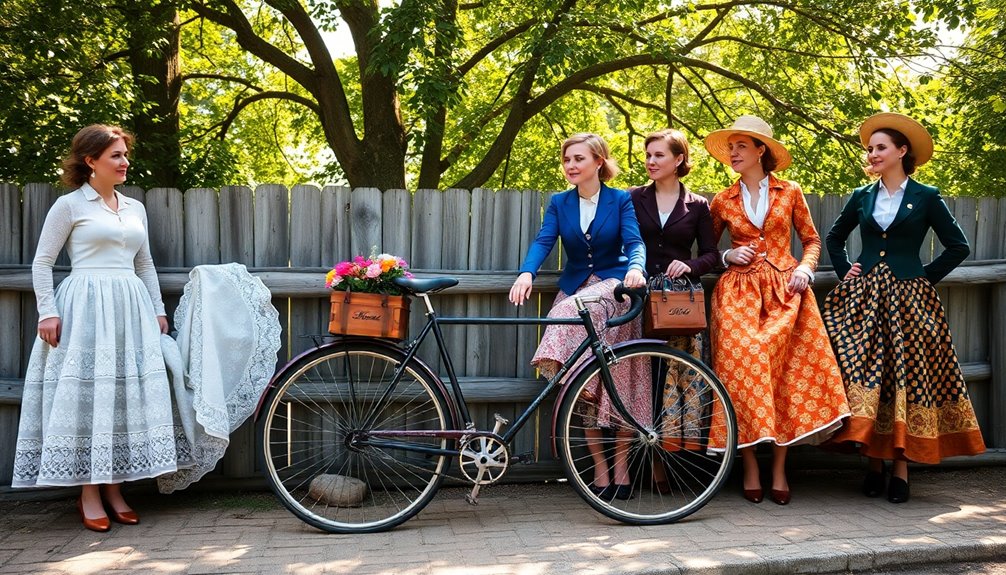Women's cycling fashion has transformed dramatically over the years. In the late 19th century, restrictive dresses gave way to practical styles like bloomers and bifurcated skirts, driven by the rise of the safety bicycle and the rational dress movement. This era marked a shift toward comfort and mobility, empowering women to embrace cycling as an activity. The journey of cycling attire reflects broader societal changes regarding femininity and freedom, hinting at a fascinating history waiting to be explored further.
Key Takeaways
- In the 1870s and 1880s, women began adopting breeches and gymnastic costumes for cycling, challenging restrictive clothing norms.
- The introduction of the safety bicycle in the 1890s revolutionized women's cycling fashion, promoting functional and modest designs.
- The Rational Dress Movement advocated for practical clothing, encouraging women to prioritize comfort and mobility over traditional feminine attire.
- Bloomers emerged as a significant alternative to skirts, enhancing women's comfort and mobility in cycling during the late 19th century.
- Modern brands like Kit & Ace and Ministry of Supply blend stylish designs with technical apparel, continuing the evolution of women's cycling fashion.
The Evolution of Women's Cycling Attire in the 1870s

In the 1870s, as cycling gained popularity, women found themselves grappling with the challenges posed by their restrictive clothing. Long dresses made it nearly impossible to mount high-wheelers, which were the favored bikes of the time.
While men in cycling wore practical gear like militarized jackets and knee-breeches, some women began to adopt more suitable attire, like breeches and gymnastic costumes, defying societal norms. This shift marked a significant evolution in women's cycling fashion.
The proposal for a ladies high-wheeler in 1874 highlighted the need for functional design that accommodated full skirts. Additionally, tricycles emerged as a respectable option, allowing upper-class women in cycling to embrace this new hobby while adhering to social expectations.
Innovations in Cycling Clothing for Women in the 1880s
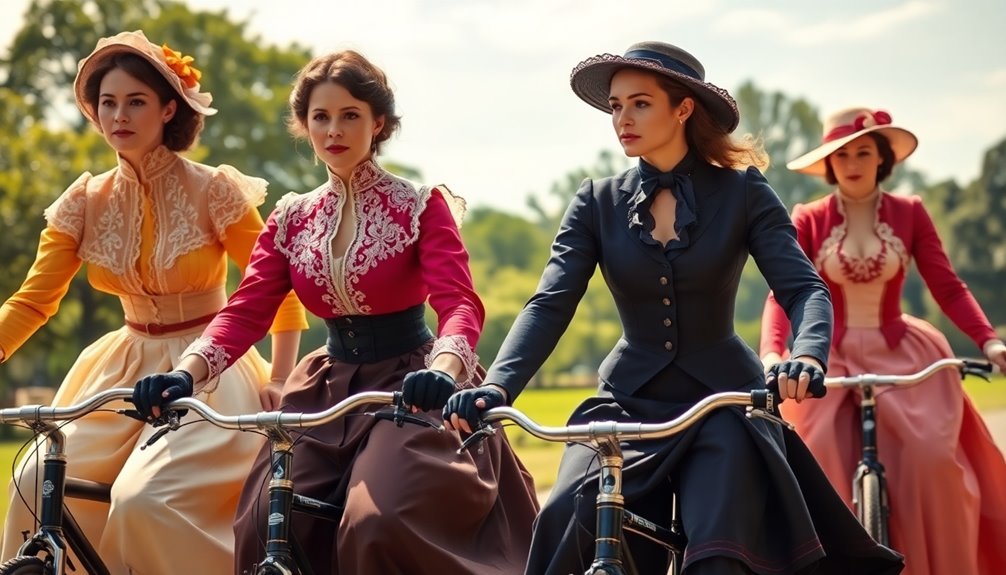
In the 1880s, cycling clothing underwent a transformation that combined practical design with stylish elements.
You'll find innovations like convertible skirts and bifurcated designs that allowed women to ride comfortably while still expressing their femininity.
As societal views shifted, cycling trousers gained traction, reflecting a growing acceptance of functional and fashionable attire for women on the move.
Practical Design Advances
As the safety bicycle revolutionized transportation in the 1880s, women found themselves needing more practical and comfortable cycling attire. Innovations in cycling gear emerged, addressing both mobility and safety concerns. Convertible skirts with buttons and pulleys were designed to enhance movement while still looking feminine. Skirt guards helped prevent entanglement in bicycle spokes, making rides safer. The rational dress movement supported the acceptance of knickerbocker-style uniforms, reflecting a shift toward functional clothing options.
| Design Innovation | Description | Impact on Women |
|---|---|---|
| Convertible Skirts | Skirts with buttons and pulleys | Enhanced mobility in cycling |
| Skirt Guards | Patented to prevent entanglement | Increased safety while riding |
| Bifurcated Skirts | Skirts designed with shorts underneath | Allowed for more comfortable cycling experiences |
| Knickerbocker Uniforms | Acceptable cycling attire in clubs | Promoted active participation in cycling |
| Trousers | Introduced as a practical alternative | Broadened options for women cyclists |
Fashion Meets Functionality
While the safety bicycle transformed transportation in the 1880s, it also sparked a fashion revolution for women that harmonized style with practicality.
As you embraced women's cycling, innovative clothing designs emerged, focusing on both functionality and modesty. Skirts featured unfastening sections and convertible designs, granting you the freedom of movement necessary for cycling.
Skirt guards were introduced to keep your attire safe from bicycle spokes and chains, enhancing your riding experience. The rational dress movement gained traction, promoting practical garments like knickerbockers and bifurcated skirts that combined femininity with mobility.
Accessories like gaiters and sport-specific corsets further reflected the shift toward active and comfortable fashion, allowing you to cycle with confidence and flair.
The Impact of the Safety Bicycle on Women's Fashion in the 1890s
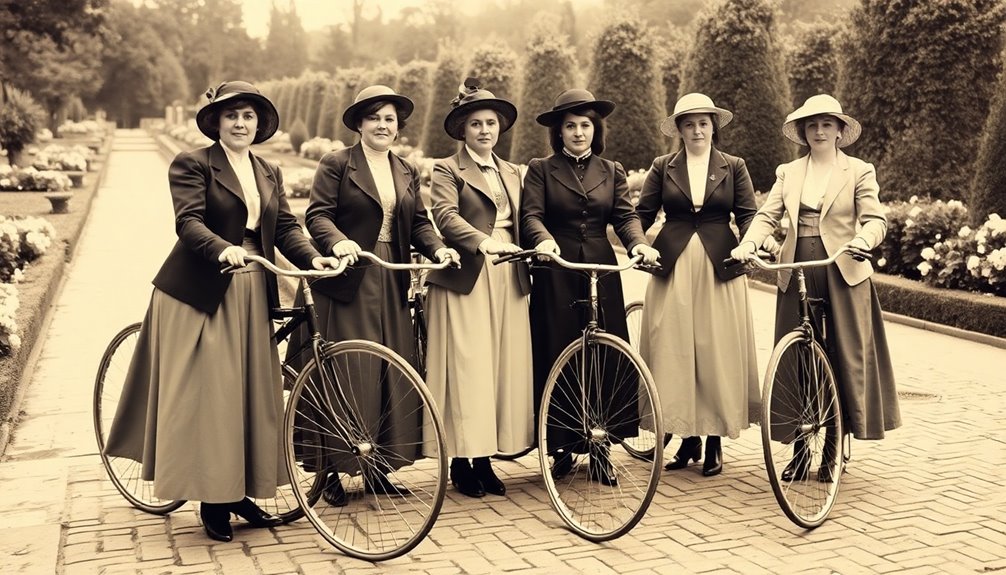
With the introduction of the safety bicycle in the 1890s, women found newfound freedom and mobility that transformed not only their cycling experience but also their fashion choices.
This stable and accessible mode of transport encouraged more women to take to the streets, leading to a surge in cycling participation.
As a response, fashion evolved to meet these needs, giving rise to bifurcated skirts and convertible trousers that blended style with practicality.
Specialized cycling costumes, featuring knickerbockers and unfastenable skirts, became popular, reflecting the era's changing attitudes.
The Rational Dress Movement also gained traction, advocating for clothing that challenged restrictive norms, allowing women to cycle comfortably and confidently.
Shops in the West End embraced this change, offering trendy cycling attire that celebrated women's active lifestyles.
The Rational Dress Movement and Its Significance
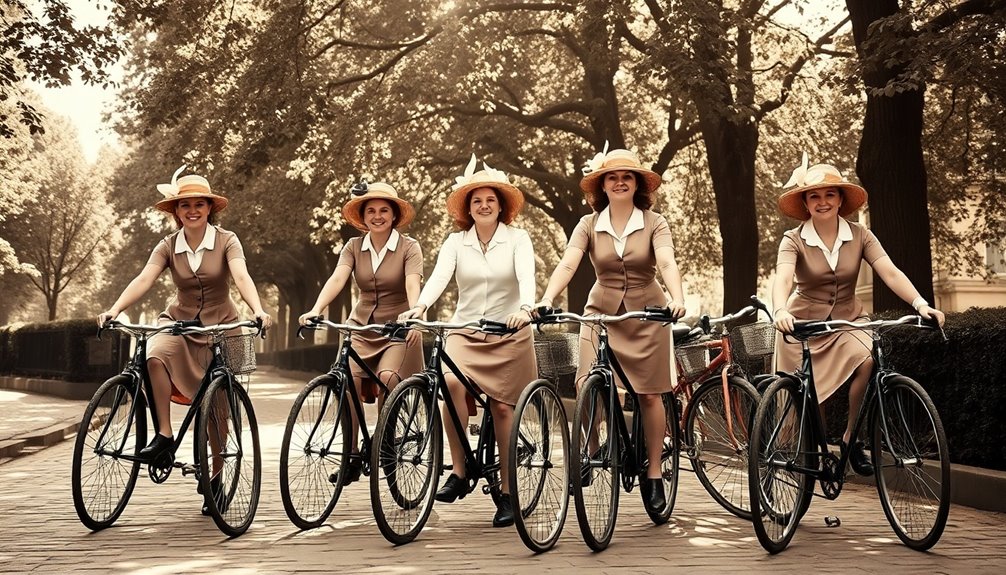
The Rational Dress Movement was a game changer for women's rights, pushing for clothing that prioritized comfort and practicality, especially for activities like cycling.
By challenging traditional norms around femininity, it allowed women to express their independence and mobility through fashion.
This movement not only influenced cycling attire but also paved the way for broader changes in women's fashion and freedom in the 20th century.
Impact on Women's Rights
As societal norms began to shift in the late 19th century, the Rational Dress Movement emerged as a powerful force advocating for women's rights through practical and comfortable clothing. Founded by Lady Florence Harberton and others, this movement challenged the restrictive fashion of the Victorian era.
High-profile incidents, like Harberton's court case for wearing rational dress, highlighted societal resistance to women's clothing choices. Advocates argued that practical attire, including bifurcated skirts and trousers, was essential for women's mobility and autonomy, aligning with broader women's rights movements.
Fashion and Freedom
Challenging restrictive fashion norms, the Rational Dress Movement not only advocated for women's rights but also redefined the relationship between clothing and freedom.
Emerging in the late 19th century, this movement promoted practical, comfortable garments, allowing women to cycle with ease. Co-founded by Lady Florence Harberton in 1881, the Rational Dress Society introduced divided skirts and other functional attire, enhancing mobility for female cyclists.
When Lady Harberton faced legal challenges for wearing rational dress, it highlighted societal resistance to change. Innovations like skirt guards and convertible garments made cycling stylish and safe.
Ultimately, embracing this movement not only facilitated women's participation in cycling but also symbolized a significant stride toward gender equality and bodily autonomy, intertwining fashion and freedom.
Lady Harberton: A Pioneer for Women's Cycling Rights
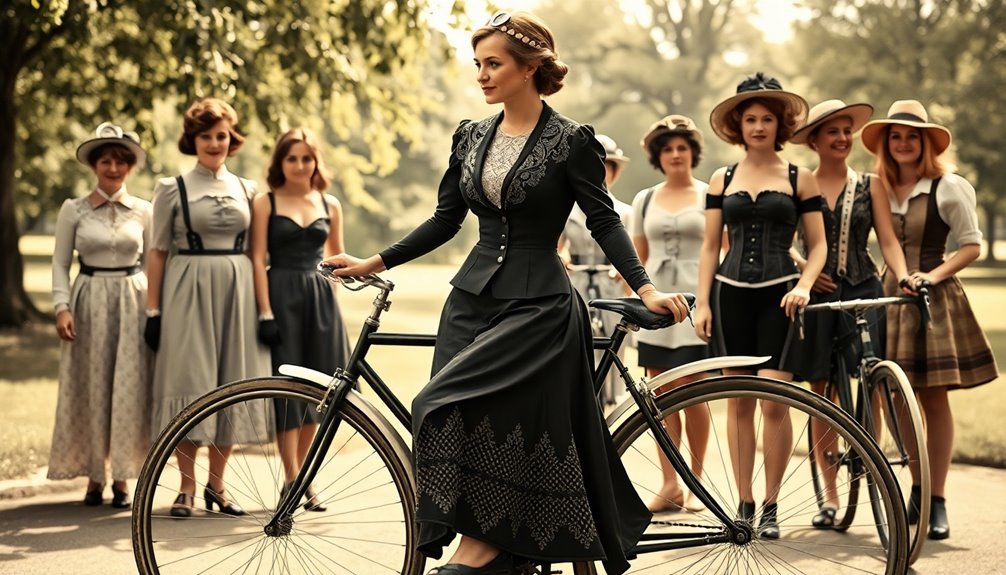
While many women conformed to restrictive fashion norms in the late 19th century, Lady Harberton emerged as a fearless advocate for cycling rights and practical attire.
As a co-founder of the Rational Dress Society in 1881, she championed comfortable clothing for women, especially cyclists.
Lady Harberton faced significant backlash for her divided skirts worn under long coats, challenging societal expectations.
In 1898, her refusal of service at the Hautboy Hotel due to her rational dress sparked a controversial court case, gaining substantial media attention.
This highlighted the struggles women faced in pursuing acceptance for practical cycling attire.
Today, Lady Harberton's legacy endures, with her name linked to a modern French brand that celebrates her impact on cycling history and women's rights.
The Role of Bloomers in Advancing Women's Cycling Fashion
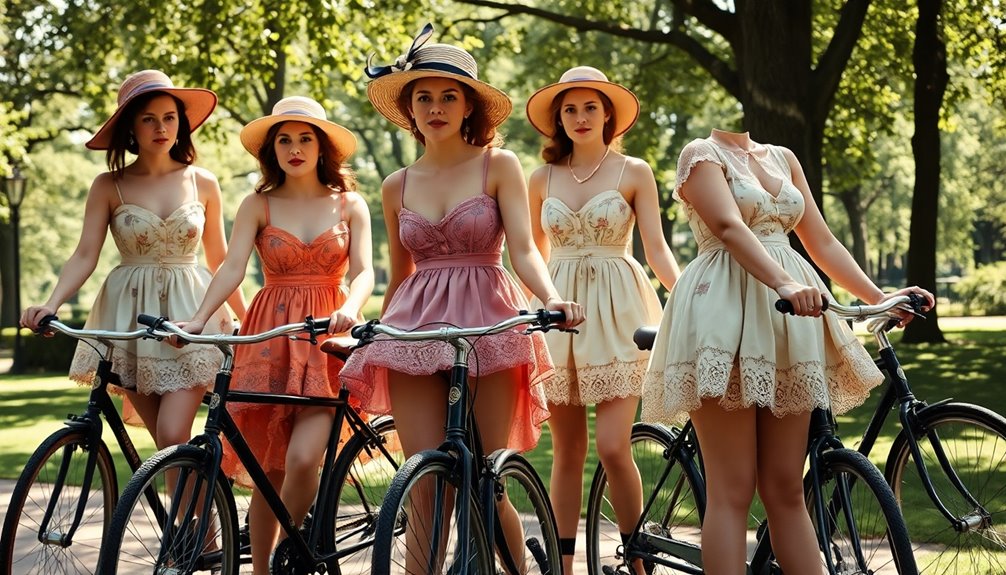
When you think about bloomers, imagine how they transformed women's cycling culture by pushing against traditional fashion norms.
These garments offered a sense of freedom and practicality that empowered women to ride without restriction.
Bloomers weren't just a trend; they represented a significant shift towards embracing feminine comfort in active pursuits.
Bloomers and Bicycle Culture
As women sought greater freedom in their clothing choices during the late 19th century, bloomers emerged as a revolutionary alternative to the restrictive skirts of the time.
These trousers, inspired by Amelia Bloomer, allowed women to embrace cycling with newfound mobility. The rise of bloomers during the Victorian era marked a significant moment in fashion history, as they became synonymous with the cycling craze of the 1890s.
Consider the impact of bloomers on women's cycling culture:
- Enhanced comfort while riding
- Greater mobility for physical activities
- A symbol of defiance against societal norms
- An important step toward rational dress
- A catalyst for women's empowerment in sports
Ultimately, bloomers helped pave the way for more practical clothing options for active women.
Fashion and Feminine Freedom
Bloomers played a pivotal role in shaping women's cycling fashion, marking a bold shift toward feminine freedom. Popularized by Amelia Bloomer in the 1850s, these garments allowed women greater freedom of movement, especially for cycling. Initially embraced for their practicality, bloomers symbolized a challenge to restrictive Victorian norms and inspired a movement toward more comfortable womens clothing that made physical activity accessible.
| Year | Key Events | Impact on Fashion |
|---|---|---|
| 1850s | Bloomers introduced | Shift to practical attire |
| 1857 | Popularity declined | Temporary setback |
| Late 19th | Cycling's rise | Renewed interest in bloomers |
| 1890s | Rational dress movement | Acceptance of trousers |
| 1900s | Broader clothing acceptance | Boost for women's rights |
Resistance to Traditional Norms
The introduction of bloomers marked not just a shift in women's cycling fashion but also a bold stand against the constraints of traditional norms. Popularized by Amelia Bloomer in the 1850s, these loose-fitting trousers empowered female cyclists to embrace mobility and comfort.
Consider how bloomers:
- Enhanced safety by preventing entanglement in bike mechanisms
- Allowed women to participate in cycling without cumbersome skirts
- Symbolized resistance against restrictive Victorian fashion
- Supported the rational dress movement advocating for practicality
- Faced societal backlash yet left a lasting legacy
Despite the ridicule, bloomers played a vital role in advancing women's cycling attire, paving the way for future generations of female cyclists to challenge conventional fashion norms.
20th Century Developments in Women's Cycling Apparel

During the 1890s, the emergence of the safety bicycle sparked a transformation in women's cycling apparel, leading to clothing that prioritized practicality and freedom of movement.
You'd notice innovations like convertible cycling garments and bifurcated skirts, combining style with functionality. These designs enhanced safety while cycling, allowing women to ride more comfortably.
The rational dress movement gained momentum, advocating for options like trousers or divided skirts under long coats, challenging societal norms. You might recall the controversy surrounding Lady Harberton's court case in 1898, which highlighted the need for acceptance of rational dress.
Modern Designers Influencing Women's Cycling Fashion
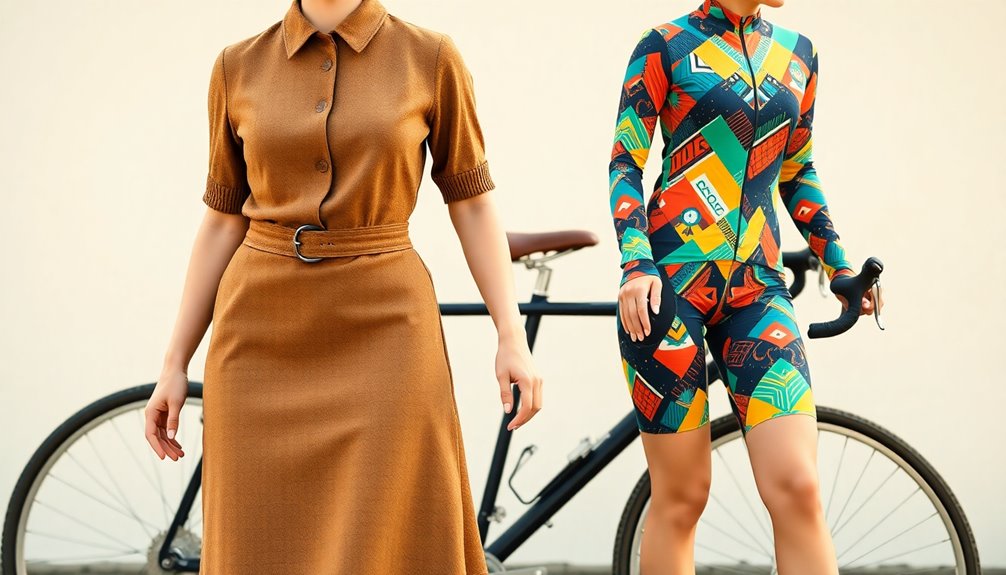
As cycling gained popularity among women in the 20th century, a new wave of designers emerged, shaping modern women's cycling fashion with a focus on style and practicality.
These modern designers are making cycling more accessible and fashionable, especially for those maneuvering urban cycling routes.
Here are some key influences in women's cycling fashion today:
- Kit & Ace: Blends technical apparel with stylish designs for female commuters.
- Ministry of Supply: Creates engineered dress clothes merging professional looks with cycling comfort.
- Willary: Offers versatile clothing options that are both stylish and practical.
- Vespertine: Specializes in fashionable safety wear using reflective materials.
- Blending Activewear: Combines classic styles with activewear for seamless changes.
These innovations reflect the evolving needs of modern female cyclists.
The Intersection of Cycling, Gender, and Social Change
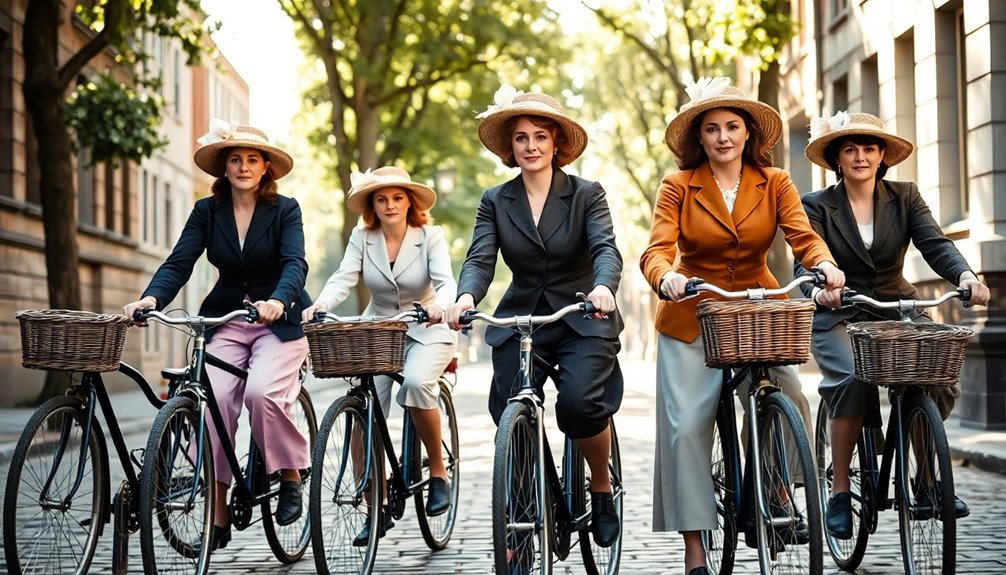
While many might see cycling merely as a recreational activity, it's also a powerful vehicle for social change, particularly in the context of gender equality. The late 19th century sparked the rational dress movement, pushing for women's cycling attire that allowed freedom of movement and challenged norms. Lady Harberton's 1898 legal battle illustrated the resistance women faced when seeking practical clothing.
| Era | Key Development | Impact on Women |
|---|---|---|
| 1890s | Introduction of the safety bicycle | Increased participation in cycling |
| Late 19th Century | Rational dress movement | Advocated for practical attire |
| 1900s | Innovations like bifurcated skirts | Redefined femininity and public roles |
This evolution symbolizes women's quest for independence and equality.
Celebrating Women's Cycling History Through Fashion

Women's cycling fashion is a vibrant tapestry woven from the threads of history, culture, and social progress. As you explore this fascinating journey, you'll find how women's cycle clothing evolved during the cycling craze of the late 19th century. The innovations back then laid the groundwork for today's stylish yet functional apparel.
Here are some key highlights:
- Bifurcated skirts and trousers challenged societal norms.
- The rational dress movement promoted comfort in cycling attire.
- Convertible skirts enhanced safety while riding.
- Amelia Bloomer's influence helped women embrace trousers.
- Modern brands blend historical designs with contemporary materials.
Frequently Asked Questions
How Did Women's Cycling Fashion Differ by Region During History?
Women's cycling fashion varied considerably by region throughout history.
In Europe, you'd see tailored skirts and blouses reflecting local styles, while in America, women often opted for more practical attire like bloomers.
In warmer climates, lightweight fabrics were popular, allowing for greater comfort.
You'd notice cultural influences shaping designs, with some regions embracing more conservative options, while others celebrated bold colors and patterns.
This diversity showcased not just functionality but also personal expression in cycling.
What Materials Were Commonly Used in Early Women's Cycling Attire?
In early women's cycling attire, you'll find materials like wool and cotton, which were popular for their breathability and comfort.
These fabrics offered flexibility and warmth, essential for various weather conditions. Some garments even included silk for a touch of luxury.
As cycling gained popularity, synthetic blends emerged, providing more durability and stretch.
You'll notice that these choices reflected both practicality and style, making it easier for women to embrace cycling as a sport.
How Did Societal Attitudes Influence Women's Cycling Fashion Trends?
They say, "clothes make the woman," and societal attitudes have always played a huge role in shaping fashion trends.
As you observe, women's cycling attire evolved with changing perceptions of femininity and athleticism. When society embraced women's participation in sports, cycling fashion became more practical and less restrictive.
Conversely, during conservative times, outfits reflected modesty, limiting freedom of movement. Your understanding of these shifts reveals how deeply intertwined fashion and societal views truly are.
Were There Any Notable Women Who Influenced Cycling Fashion Directly?
Yes, several notable women have influenced cycling fashion directly.
Figures like Beryl Burton and Jeannie Longo not only excelled in their sport but also shaped what women wore while cycling.
Their achievements inspired brands to create functional and stylish clothing tailored for female cyclists.
You can see how their presence challenged traditional norms, pushing for designs that catered to performance and comfort, ultimately changing the landscape of women's cycling attire.
How Do Modern Trends in Cycling Fashion Compare to Historical Styles?
Modern trends in cycling fashion emphasize comfort, style, and performance.
You'll notice sleek materials and vibrant colors that enhance both functionality and aesthetics. Unlike historical styles, which often prioritized modesty over practicality, today's cycling wear is designed for freedom of movement and breathability.
You can mix and match pieces to express your personality while benefiting from advanced fabrics.
Conclusion
As you reflect on the journey of women's cycling fashion, you can see how it mirrors the strides women have made in society. From the restrictive garments of the 1870s to modern, stylish activewear, each era tells a story of progress and empowerment. Like the spinning wheels of a bicycle, these changes propel women forward, breaking barriers and redefining freedom on two wheels. Embrace this rich history and let it inspire your own cycling adventures.
